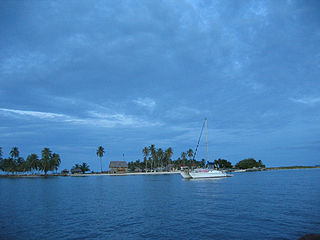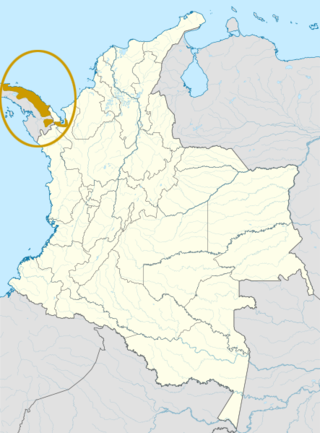
This is a demography of the population of Panama including population density, ethnicity, education level, health of the populace, economic status, religious affiliations, and other aspects of the population. Panama's 2020 census has been postponed due to the COVID-19 pandemic but the government are currently assessing additional implications. They are evaluating the preparatory processes that can begin now, such as procurement.

Guna Yala, formerly known as San Blas, is a comarca indígena in northeast Panama. Guna Yala is home to the indigenous people known as the Gunas. Its capital is Gaigirgordub. It is bounded on the north by the Caribbean Sea, on the south by the Darién Province and Emberá-Wounaan, on the east by Colombia, and on the west by the province of Colón.

Los Santos is a province in Panama, reaching from the La Villa river in the North to the Pacific Ocean in the south and east. It is part of the Azuero Peninsula, bounded by the province of Herrera to the north and northeast, and by Mariato District of Veraguas Province to the West. The City of Las Tablas is the capital and most populous city. There are seven administrative districts under the jurisdiction of Los Santos Province. Los Santos's area is 3,809.4 km ², and its population is 98,466 inhabitants in 2023.

The Guna are an indigenous people of Panama and Colombia. Guna people live in three politically autonomous comarcas or autonomous reservations in Panama, and in a few small villages in Colombia. There are also communities of Guna people in Panama City, Colón, and other cities. Most Guna live on small islands off the coast of the comarca of Guna Yala known as the San Blas Islands. The other two Guna comarcas in Panama are Kuna de Madugandí and Kuna de Wargandí. They are Guna-speaking people who once occupied the central region of what is now Panama and the neighboring San Blas Islands and still survive in marginal areas.

Guna de Wargandí or Wargandí, formerly known as Kuna de Wargandí is a comarca indígena and corregimiento in Pinogana District, Darién Province, Panama with a population of 1,914 as of 2010. It was created by Law 34 of July 25, 2000, from the province of Darién, from the district of Pinogana. It has an area of 775 square kilometres (299 sq mi). It is inhabited by the Guna people.

Gaigirgordub, called El Porvenir until July 1, 2016, is the capital of the Panamanian comarca of Guna Yala. The settlement is located on a small island and contains a landing strip, a museum, a hotel, government offices, and an artisans' cooperative. There is also a small beach.

The San Blas Islands of Panama is an archipelago comprising approximately 365 islands and cays, of which 49 are inhabited. They lie off the north coast of the Isthmus of Panama, east of the Panama Canal. A part of the comarca (district) Guna Yala along the Caribbean coast of Panama, it is home to the Kuna people.

The Kuna language, spoken by the Kuna people of Panama and Colombia, belongs to the Chibchan language family.
Abya Yala is a neologism used by some indigenous peoples of the Americas to refer to the American continent. The term is used by some indigenous organisations, institutions, and movements as a symbol of identity and respect for the land one inhabits. The increasing usage of the term can be viewed in the context of decolonization, as it serves to create an understanding that "land and discourse, territorio y palabra, cannot be disjointed" and a geography in which a struggle for sovereignty and resistance occurs on an everyday basis for Indigenous communities.
Ukupseni or Uggubseni, also called Playón Chico, is one of the most populous islands in the Guna Yala territory of Panama, 100 metres (330 ft) from the mainland. The literal translation for Ukupseni is 'little beach' in English, or playa chica in Spanish, thus Playón Chico is a mistranslation, which means roughly 'Little Big Beach'.
Achutupo is an island town in the San Blas archipelago of Panama, located .7 kilometres (0.4 mi) off the Kuna Yala comarca (district) coast. The island is sometimes called Isla Perro or Dog Island. It has a total area of around 0.1 km2, with a population density of around 15,860 people per km2, resulting in Achutupo being one of the most densely populated islands in the world.

Cartí Sugtupu, also spelled Gardi Sugdub, is an island in the San Blas Archipelago in the Guna Yala province of Panama. It is the southernmost and largest of four populated Carti Islands, and it lies 1200 meters off the northern coast of mainland Panama. The island is densely populated and houses a small harbour and a museum. Its indigenous inhabitants are Guna.

Indigenous peoples of Panama, or Native Panamanians, are the native peoples of Panama. According to the 2010 census, they make up 12.3% of the overall population of 3.4 million, or just over 418,000 people. The Ngäbe and Buglé comprise half of the indigenous peoples of Panama.
Rio Sidra is a densely populated island town in the San Blas Archipelago of the Kuna Yala comarca of Panama. Among the native Guna population, the island is called, Urgandi. The island is 1 kilometre (0.6 mi) off Panama's north coast. Rio Sidra is a municipality or corregimiento of Narganá.

Guna de Madungandí or Madungandí, formerly known as Kuna de Madugandí is a comarca indígena and corregimiento in Chepo District, Panamá Province, Panama with a population of 4,271 as of 2010. It was created by Law 24 of January 12, 1996. Its population as of 2000 was 3,305.

The Cayos Limones or Lemon Keys are a group of Caribbean islands in the San Blas Archipelago in Guna Yala province of Panama. As part of the autonomous Guna Yala indigenous territory it is mainly populated by the Guna indigenous People. The islands in Cayos Limones are sparsely populated. The most notable of the islands are Isla de Perro and Chichimen, both are situated near substantial reefs making them ideal for snorkeling, as they contain several sunken ships. The economy is mainly based on tourism, fishing and coconut harvesting. The Keys are connected to the other islands of the archipelago and to the mainland by taxi-boat, normally through the other islands of El Porvenir or Carti Sugtupu.

The San Blas Rebellion, Guna Revolution or Revolution of Tule was an uprising by the Kuna, to declare independence, in the San Blas Islands, in February 1925.
Petita Ayarza Pérez is a Panamanian Indigenous political leader and businesswoman. In the 2019 general election, she became the first Guna woman to run for a seat as deputy and be elected to the National Assembly of Panama.
Narvagandub Dummad is an island off the northeast coast of Panama. The Spanish colonizers called this island, Naranjos Grandes or Big Orange Trees. The island is part of the chain of islands named San Blas Islands, which stretches from the east of the Panama Canal up to the border of Colombia. The archipelago is inhabited by the Guna people, a Native American ethnic group that resides in border areas of Panama and northern Colombia. Their language is part of the Chibchan language family













